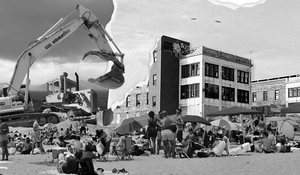Four Notes on Riis Beach
- Note I: The Backyard
- Note II: A Confused Position
- Note III: Party Foul
- Note IV: Mistaking the Party for the Political
Table of Contents

Note I: The Backyard
Queer people of color have frequented the strip of sand near the Neponsit Beach Hospital as a backyard of sorts. Enclosing the easternmost end of Jacob Riis Beach, the hospital creates a unique space that’s both isolated and intimate yet also simultaneously public, open, and free. Whereas they may otherwise have chosen to hold hands and kiss in the sun on a rooftop or backyard, those amenities are financially out of reach for most young queer people of color in today's hyper-gentrified NYC.
Early in 2022, news came that the Neponsit Beach Hospital would be demolished, and a parking lot and lifeguard facility erected in its place.
This end zone has taken on a sublime significance: a symbol for communities worth persevering through political organizing and agitation. Queers are in the early stages of coming together to strategize how to organize for a desirable outcome regarding the impending alteration to the landscape they love. Several counter proposals are circulating. Gays Living in a Transgender Society (GLITS), a not-for-profit lead by Ceyenne Doroshow, has taken a leadership role in rallying queers around her personal vision for a land trust and transgender healthcare center on the site. The ideological framework underlying the organizing project, common to many community land disputes in NYC, is that the community’s long term use of the space entitles them to democratic participation in determining its the space’s future, and a right to remain its users.
This proposal is not moving forward. Others hope to see the crumbling building simply remain as is.
At the heart of the organizing lies important political questions about the built environment’s ability to accommodate specific communities of identity and their claim to a set of space and time. An accounting of the spatial significance of Neponsit Beach Hospital places it at the intersection of several sets of geographies: unceded Lenni-Lenape territory, publicly owned land of New York City, the psychic terrain of four generations of queers. Which of those ontologies are queers fighting for today?

Note II: A Confused Position
Riis Beach became gay during a period of investment, not disinvestment.
The theorized relationship between homosexuality, neighborhood change, and investment is fraught. At times queers have thrived in uninvested or disinvested forgotten spaces, yet some propose that their mere presence primes those spaces for gentrification. Nowadays, queers claim that it’s Riis’ disinvestment that somehow makes it safe, that its disinvestment is what needs preserving. But this is a confused position.
The prevailing positions on what should be done with the Neponsit Hospital begin from the assumption that the land is publicly owned by the City and residents have the right to block or shape future land use decisions. The GLITS strategy is no different. They assume the form of a typical non-profit campaign: wielding the influence of the organizations’ leadership, network, and political ties to influence the shape and outcome of the City’s final plan for the land. Increasingly, non-profit led campaigns like these call upon the city to dispose of its land holdings into non-profit ownership for specific housing or cultural uses. While the stated aim of such a strategy is to common the land, this trend is representative of a long-standing confusion among NYC organizers.
Let’s just call a spade a spade: placing publicly-owned land into the ownership of a non-profit land trust is, in fact, privatization.

Note III: Party Foul
Riis beach is a party, frequented by artists, nightlife personalities, non-profit and cultural workers — many of them drawn by the recent organizing efforts.
In recent years, it has become commonplace within this milieu to acknowledge and engage in the crowded discourse on settler colonialism to the degree that an organization’s work engages with questions of land and space. This manifests usually in the growing practice of land acknowledgements, “a formal statement that recognizes and respects Indigenous Peoples as traditional stewards of this land and the enduring relationship that exists between Indigenous Peoples and their traditional territories.”
There is a contradiction between the acknowledgement of unceded Lenni-Lenape territory and a campaign strategy built on seeing the land as publicly owned, all the while seeking to place it in the private ownership of a land trust.
There is also another contradiction in the fact that the queers staking a claim to the beach live quite far from it. Following their logic, the homeowners of Neponsit should have stronger claims to the land.
Missing from the mainstream discourse is the idea that indigenous New Yorkers hold the strongest claim to the use of the land and future development — a party foul.

Note IV: Mistaking the Party for the Political
There is an impulse to assume that cultural spaces, as well as their festivities, take on political significance if the communities that frequent them are from marginal backgrounds. Queer identity is not inherently political nor radically good, and neither are their spaces. However, that queer people are drawn to the spatial margins of society is a noteworthy phenomenon. The barrier islands, the corners, the dark rooms, the basements, the abandoned piers.
But while nightlife is integrally tied to the survival practices of political communities — as spaces of joy, recreation, disassociation, therapeutic bonding, etc. — they are not politics itself. Politics is always, only and ever, collective action taken towards the achievement of specific forms of social organization. Politics can return us to old forms of social organization, maintaining the status quo, or reap something new.
In this sense, it is easy to confuse the party for the political. It takes collective action to create spaces of joy and recreation when they are illegal. The ability to create art, culture, music, dance are perhaps the highest pursuit of politics, politics as a struggle to create a world where everyone is housed, fed, educated, and healthy enough to participate in these forms. It will take politics to protect and proliferate queer spaces for partying.
A queer politics applied to questions of land tenure would need to seriously engage the existing claims of indigenous communities’ right to the land, posing serious questions about what solidarity organizing looks like in the current land dispute.
Some propose staking out a new queer area in what is actually an already partially queer Ft. Tilden Beach. If queers want to colonize Ft. Tilden or stay at Riis, there is ample space for queer life in either zone. A more salient question, however, is the political meaning of the word “queer” and what it entails in negotiations surrounding land tenure.
From a public site development standpoint, the queers currently at Riis Beach will likely be recognized as legitimate and even special stakeholders in the public land development process. It is difficult to predict how the development process will unfold or what new meanings the future public space project will hold. There is no inherent belonging or pre-inscribed appropriate use of land. The cultural groups involved must actively inscribe the meaning themselves each day. It is the only way to be sure.
Native American Council, “Acknowledgement of Land and Sovereignty,” https://nativeamericancouncil.org.uiowa.edu/acknowledgement-land-and-sovereignty.